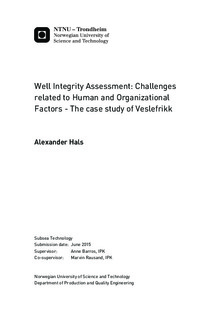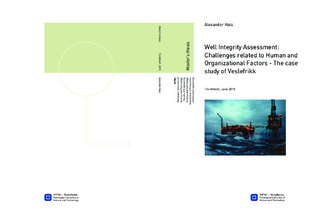| dc.description.abstract | Well integrity affects safety, humans, the environment, production, reputations and assets value. The concept of well integrity in relation to human and organizational factors have gained considerable attention in the petroleum sector inNorway over the last few years. This is not without reason. Resent studies shows that a simple mistake like dropping a hammer, may not only be caused by the obvious direct cause like inattention but may be caused by several underlying causes such as deficiencies in the design of the drill floor, operating instructions, follow-up of safety notices, competence, planning and implementation, deficient management, and breach of procedure. Historical events like the Piper Alpha incident shows that this underlying causes or human and organizational factors are vital to develop and improve the systems. This means that by improving human and organizational factors may contribute to the improvement of well integrity.
This thesis will explain the concept of human and organizational factors through a detailed
literary survey. Different models and methods has been presented (the human performance
model, Decision making, the "step ladder" decision model, performance influencing factors,
human error causation paradigm, human-,technology- and organizational concept) to give the
reader a decent understanding of the concept. It is important for this thesis that the reader is given a detailed insight in this aspect since most of the main objectives in this project is answered using these models and methods.
Human error has been identified as a primary causal factor in 70-80% of accidents in the
oil and gas industry. Identifying and classifying the human and organizational factors of an accident is an effective tool to assist in the investigation process, the target training and make it easier to implement prevention efforts. Through discussions and careful analysis of five methods deemed fit for classification of human and organizational factors in the oil and gas industry, was the STEPP method identified as the best classification scheme for human and organizational factors relevant to well integrity in various phases of a well s life.
Well integrity is vulnerable to unforeseen factors that have a critical influence on the work
performance. Understanding these unforeseen factors and the relationship between themthrough
a human, technological and operational perspective can give better working environment and an opportunity to improve the health, safety integrity, and work performance. Challenges reviled
through the human, technological and organizational perspective was identified and categorised as: well control training and knowledge, well integrity training and courses, human computer interface, qualification and testing ofwell barrier elements, verification ofwell barrier elements, automation, national and international standard, well integrity management system, handover documentation and well barrier schematics.
Challenges related to human and organizational factor at Veslefrikk has been identified using the humanerror causation paradigms. The different paradigms (the engineering error paradigm, the individual error paradigm, the cognitive error paradigm and the organizational error paradigm) look at the situation from different points of view. Veslefrikk have challenges related to the driller s chair, placement of communication equipment, disturbing elements, alarms with no essential function, drillers workload, service companies and their lack of risk understanding, difficulty in locating relevant procedures, the sheer amount of procedures, time pressure, installation specific training, experience and meetings is being prioritized ahead of actual drilling operation and the departure meetings are too general. Comparison with the overall industry shows that the HO factor situation on Veslefrikk is all in all better. Measures can be initiated to eliminate the identified challenges at Veslefrikk and in the overall industry. | |

